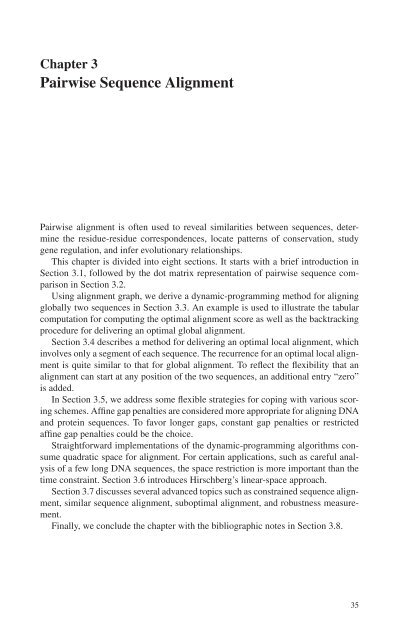Create successful ePaper yourself
Turn your PDF publications into a flip-book with our unique Google optimized e-Paper software.
Chapter 3<br />
Pairwise <strong>Sequence</strong> Alignment<br />
Pairwise alignment is often used to reveal similarities between sequences, determine<br />
the residue-residue correspondences, locate patterns of conservation, study<br />
gene regulation, and infer evolutionary relationships.<br />
This chapter is divided into eight sections. It starts with a brief introduction in<br />
Section 3.1, followed by the dot matrix representation of pairwise sequence comparison<br />
in Section 3.2.<br />
Using alignment graph, we derive a dynamic-programming method for aligning<br />
globally two sequences in Section 3.3. An example is used to illustrate the tabular<br />
computation for computing the optimal alignment score as well as the backtracking<br />
procedure for delivering an optimal global alignment.<br />
Section 3.4 describes a method for delivering an optimal local alignment, which<br />
involves only a segment of each sequence. The recurrence for an optimal local alignment<br />
is quite similar to that for global alignment. To reflect the flexibility that an<br />
alignment can start at any position of the two sequences, an additional entry “zero”<br />
is added.<br />
In Section 3.5, we address some flexible strategies for coping with various scoring<br />
schemes. Affine gap penalties are considered more appropriate for aligning DNA<br />
and protein sequences. To favor longer gaps, constant gap penalties or restricted<br />
affine gap penalties could be the choice.<br />
Straightforward implementations of the dynamic-programming algorithms consume<br />
quadratic space for alignment. For certain applications, such as careful analysis<br />
of a few long DNA sequences, the space restriction is more important than the<br />
time constraint. Section 3.6 introduces Hirschberg’s linear-space approach.<br />
Section 3.7 discusses several advanced topics such as constrained sequence alignment,<br />
similar sequence alignment, suboptimal alignment, and robustness measurement.<br />
Finally, we conclude the chapter with the bibliographic notes in Section 3.8.<br />
35

















